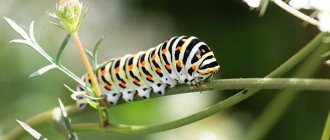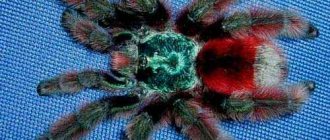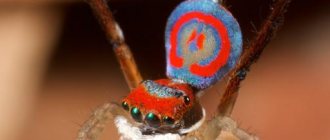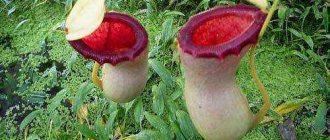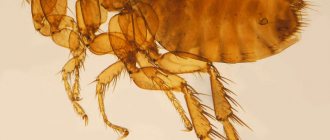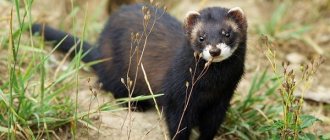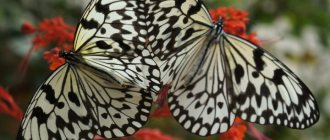Types of caterpillars
The following types of caterpillars are most often found on the territory of Russia: cabbage white or cabbage moth, peacock eye, moth, clothes moth, redtail, hawk moth, admiral, swallowtail. Let's look at each of these types in more detail.
Cabbage butterfly
Photographer – Anzhelika Taranenko (NekoByaka)
This type of caterpillar is quite common. They are found in the European region of Russia. The appearance is represented by a green body with a length of about 3-4 centimeters. There are dark hairs and tubercles on the surface of the body. This name is due to the fact that this caterpillar can be found in cabbage. However, they can feed on radishes, turnips, turnips and other crops. For this reason, cabbageweeds are pests. The caterpillar stage in these species lasts about 2-5 weeks. It is determined by weather conditions.
Moth
In another way, moths are called land surveyors. This name is due to the fact that they have underdeveloped front false legs, and therefore move in a very specific way. This representative is distinguished by its brown body color, thanks to which it manages to hide well among vegetation. The moth also has a well-developed muscular system, which is why it can remain in an elongated, motionless state for quite a long period of time. The food of moths is limited to coniferous trees, hazel trees and currant foliage. The body of this species is quite wide and colored in delicate shades.
Redtail
It is found in the forest-steppe zone. The redtail feeds mainly on the leaves of bushes. The body of this representative is covered with gray-brown hairs. At the end of the body there is an area painted bright scarlet. This sign indicates that the caterpillar is poisonous, so contact with it can lead to an allergic reaction. It is also a pest because it destroys fruit trees. The redtail's summer period lasts from May to June.
Swallowtail
A variety of swallowtail caterpillars are quite large in size. They spread throughout Europe, North America and Asia. Also found in Africa. The caterpillar is distinguished by its incredible color, which can change. For this reason, it is considered no less beautiful than a butterfly. At first, the swallowtail is covered with bright red spines, and after that it becomes green with dark stripes and brownish spots. The main diet is carrots, parsley, celery and wormwood.
Blind Hawkmoth
It is found in central Russia, in Siberia and the Far East. It feeds mainly on the leaves of birch, poplar and willow. The body is painted green, so it can be overlooked against the background of foliage. There are also thin diagonal stripes of dark green color on the surface of the body, and a small appendage protrudes from the tail.
Peacock eye
The caterpillar of this species reaches a body length of about 10 centimeters. In total, there are two types of these representatives: day and night. It feeds mainly on fruit trees such as pears, walnuts, plums, apple trees and cherries.
Admiral
Spread throughout various regions of Russia. Their appearance is similar to butterflies. The caterpillar's body is black with characteristic yellow stripes on the sides. They are most often found in May. The admiral forms a shelter of leaves around itself, where it spends most of its time until the end of summer, after which it emerges and turns into a butterfly.
In addition to the above-mentioned caterpillars, which are relatively harmless, there are also a large variety of poisonous representatives. The main ones:
Poisonous caterpillar
This insect has a similar appearance to an animal covered with fur. It is one of the most poisonous. You can meet it in Mexico. Under the peculiar fur there are poisonous and sharp thorns, which can be light gray or brownish in color. The length of the caterpillar does not exceed 2 centimeters. Contact with this representative may result in redness of the skin, enlarged lymph nodes, chest pain and shortness of breath.
Saddle Caterpillar
The body of this species is bright green with brown spots at the base. There is also a brown spot in the middle, which is edged with white. They spread to North and South America. There are two pairs of horns on the body, which are equipped with a poisonous solution. Injections from these horns can cause severe pain, nausea and rash. These symptoms may last for several days.
Lazy clown
Most often this insect is found in Mozambique and Uruguay. Lives mainly in the shade under the foliage of trees. This caterpillar is famous for the most dangerous toxin that accumulates in its herringbone-shaped shoots. Representatives of this species reach a body length of up to 7 centimeters with a green-brown color. Poisoning by the toxin of this caterpillar can lead to hemorrhage at the site of the bite, diseases of the gastrointestinal tract, as well as pulmonary edema and disorders of the nervous system.
Butterfly larva
Butterflies have several stages of development. The adult lays eggs on the underside of a leaf, on the fruits of fruit trees or garden crops, or in another secluded place. After some time, larvae emerge from the eggs - small worms that must consume a lot of food in order to develop and move to another stage.
Butterfly larvae are called caterpillars. The insect can remain in this stage from several days to several years. During this period, the caterpillar actively feeds and often becomes a pest of a plant, eating its fruits, leaves or bark. The larva then forms a cocoon around itself and turns into a pupa. After a certain time, an adult individual emerges from it - an imago, known to everyone as a butterfly.
Interesting!
Butterflies and their caterpillars have a direct size ratio. Large caterpillars are the larvae of large butterflies, and vice versa.
Varieties of caterpillars differ in size, appearance, habitat, but have a common body structure. The body of a butterfly larva consists of several segments:
- a well-defined, rounded head with oral apparatus, visual organs, and horn-shaped antennae;
- breast;
- abdominal region;
- several pairs of limbs.
Caterpillars have several eyes, usually 5-6 pairs located next to each other. The mouth opening is equipped with small teeth for gnawing plants. The body is covered with small hairs and spine-like outgrowths. The caterpillar itself is very mobile and is capable of quickly moving across the surface, hooked with hook-like legs.
Classification
Each butterfly was a caterpillar, and the color of the caterpillar may differ from the color of the butterfly. Most often, caterpillars are herbivorous insects, but predators can also be found in nature. Depending on their food, caterpillars are divided into the following classes:
Polyphages. This type of caterpillar feeds on almost any plant. They represent butterfly species such as wine hawk moth, blind hawk moth, kaya bear, peacock eye and other insects.
Monophages . These caterpillars prefer to eat only specific types of plants, which is where their names come from. Examples of monophages include cabbage moths, apple moths, silkworms and other species.
Oligophages. The food of these insects is limited to one type of plant that belongs to a specific family or type. As a rule, this is a pine butterfly, swallowtail, polyxena.
Xylophagous. The diet of this class is varied with various tree barks. Such caterpillars are leafworms, woodworms, and so on.
Caterpillars also differ in their distribution area. A number of species inhabit the subtropics, and some inhabit the northern regions. Among the large number of caterpillars, there are also quite valuable representatives, for example, silkworms. Silk threads are obtained from their cocoon.
Swallowtail
Swallowtail butterfly and its caterpillar
A fairly large caterpillar lives in Europe, Asia, North America, and northern Africa. Its color is not inferior in beauty to the appearance of an adult. Photos of the caterpillar clearly demonstrate color changes. At the first stage of its development, the caterpillar is black with bright red spines. Then it becomes striped - green with black stripes, decorated with red spots. The bright swallowtail caterpillar eats various crops:
- carrot;
- parsley;
- celery;
- sagebrush;
- alder.
Habitat
Most often the caterpillar can be found on the ground, but many representatives have begun to develop under water. For example, the Hawaiian moth caterpillar has spread on land and in water.
Caterpillars are also divided into two types, according to which they lead either a secretive or free lifestyle. Caterpillars, which lead a free lifestyle, live on the foliage of plants and are large in size. Secretive caterpillars include a number of varieties:
- Leafworms. They hide in the curled leaves of various trees.
- Frugivores. Their habitat is limited to tree fruits;
- Drillers. They can only be found inside trees and shoots;
- Miners. These species make special passages in the buds, leaves and petioles;
- Gall formers. They are famous for causing pathology in the growth of damaged plant parts.
Clothes moth
Clothes moth larvae
Clothes moth larvae cause great damage to people's personal belongings. The white caterpillar with a brown head feeds on wool, fur products, and cotton fabric. The female moth lays eggs in closets, pantries, and warehouses where outerwear made from natural materials is stored.
On a note!
The larval stage of the clothes moth can last from one month to two years. The caterpillar is able to go without food for several days and withstand significant temperature changes.
Clothes moth caterpillars are recognized as the smallest - the length of their translucent body varies from 1 to 12 mm. The more food they consume, the longer and thicker they become. The pest lives everywhere in Eurasia, North America, Australia, and some African countries.
Signs of colonization of an area by woodworm
The population of this pest can be identified by the following signs:
- sap found at the bottom of the trunk;
- the sharp and persistent smell of wood vinegar, which is felt next to the tree trunk;
- wide passages, oval in shape on branches and bark;
- drill flour on the surface of the bark. It looks like small sawdust of brown or yellow color;
- changes in the appearance of the tree: dried branches, bark falling away from the trunk, falling leaves.
In some cases, the pest can be detected by caterpillars migrating along the ground to the place for pupation.
Damage caused by woodworm
The main damage to trees is caused by caterpillars. Immediately after hatching from the eggs, they reach the young shoots and penetrate inside, to the core. As it grows, the pest's passages increase in length, first horizontally, damaging blood vessels and weakening the tree, then downward to the base of the trunk.
A tree affected by woodworm loses its attractiveness: shoots die en masse, leaves in the crown dry out and fall off. Yields of fruit crops are sharply reduced. The tree becomes weakened and cannot resist fungal and bacterial diseases. In the absence of measures aimed at exterminating the pest, it completely dries out and dies.
What methods of woodworm control do you use?
Folk
Chemical
Silkmoth (Hubbard's Small Silkmoth)
This is exactly the famous caterpillar that makes silk thread, and people make wonderful fabric from it. These larvae eat only mulberry or mulberry leaves.
The silkworm butterfly is nocturnal.
The harpy is big. Cerura Vinula
Due to its unusual appearance, the great harpy caterpillar is called the forktail, due to the unusual appendage at the back of the body.
The completely green caterpillar has a diamond-shaped purple spot on its back, making it one of the most beautiful caterpillars on the planet.
In times of danger, it raises and inflates the front part of the body, and then retracts into the first segment of the body. Fork-shaped processes also serve for protection, from which this amazing creation of nature releases a caustic liquid.
14
Peacock-eye Hercules. Coscinocera Hercules
The caterpillars of these butterflies can reach a record length of 12 cm, which is why they are also called giant caterpillars. According to thebiggest.ru resource, this is one of the largest caterpillars in the world, second in size only to the king nut moth caterpillar.
In addition, they have a very unusual color and body structure. The blue-green caterpillars have reddish spiracles and the entire body is covered with yellow spines.
Of the closest relatives of the Hercules peacock eye, the Chinese and Japanese peacock eye are used to produce silk.
11
What does it eat?
The basis of the diet of the odorous woodworm is made up of deciduous species growing both in the garden and in the forest:
- willow;
- poplar;
- oak;
- alder;
- aspen;
- Walnut;
- Apple tree;
- pear;
- Rowan;
- Linden;
- white acacia.
The caterpillars feed on the bark and the wood itself, making passages and burrows in the trunk.
Most often, the pest damages species with soft wood or trees growing singly, as well as weakened and diseased plants.
